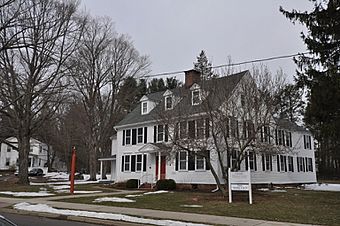Cheshire Historic District facts for kids
Quick facts for kids |
|
|
Cheshire Historic District
|
|
 |
|
| Location | Roughly bounded by Main St., Highland Ave., Wallingford Rd., S. Main, Cornwall, and Spring Sts., Cheshire, Connecticut |
|---|---|
| Area | 35 acres (14 ha) |
| Built | 1720 |
| Architect | Hoadley, David; Et al. |
| Architectural style | Colonial Revival, Late Victorian, Colonial Cape;Georgian |
| NRHP reference No. | 86002793 |
| Added to NRHP | August 29, 1986 |
The Cheshire Historic District is a special area in the town of Cheshire, Connecticut. It includes the old town center, which is full of historic buildings. This district shows how the town has grown and changed over more than 200 years. It was added to the National Register of Historic Places in 1986. This means it's recognized as an important historical site in the United States.
Contents
Exploring Cheshire's Historic Heart
The Cheshire Historic District is like a living museum. It helps us understand what life was like long ago. This area is mostly along Main Street and Wallingford Road. It covers about 35 acres, which is roughly the size of 26 football fields!
A Look at the Buildings
Most of the buildings here are homes built before 1850. They are usually made of wood and have sloped roofs. You can see houses that are one-and-a-half or two-and-a-half stories tall. These old buildings show different styles of architecture from the past.
Besides homes, the district also has important public buildings:
- The First Congregational Church, built in 1826.
- Two other churches.
- The Town Hall, built in 1867. It's a great example of Greek Revival style architecture.
- An old commercial building from the late 1700s on South Main Street.
Cheshire's Story: From Farms to Suburbs
Cheshire has a long and interesting history. It started as a small settlement and grew into the town we know today.
How Cheshire Began
People from Wallingford first settled in Cheshire in 1694. For a while, it was part of Wallingford. Then, in 1780, Cheshire became its own separate town. The town center grew up around the first "meeting house." This was a building used for both religious services and town meetings. Today, the First Congregational Church stands in that same spot.
Life in Early Cheshire
In its early days, Cheshire was mostly a farming community. People grew crops and raised animals. The only businesses were small mills. These mills used water power to saw wood or grind grain for local families.
Growth and Change
In the mid-1800s, Cheshire saw some changes. People discovered copper and barite (a type of mineral) in the area. Mining these materials brought new jobs and growth. Better transportation, like new roads, also helped businesses expand.
By the 1900s, Cheshire started to change again. It became a "suburban bedroom community." This means many people who lived in Cheshire traveled to nearby cities for work. They would come home to Cheshire to sleep, making it a quiet place to live.




